The Standing Committee
by Joanna Fiduccia
Not all artists can come to the United States, but sometimes a sculpture can stand in their place. Los Angeles encounters the effigies of an exiled American; in New York, chocolate statues from the Congo have the whiff of colonialism
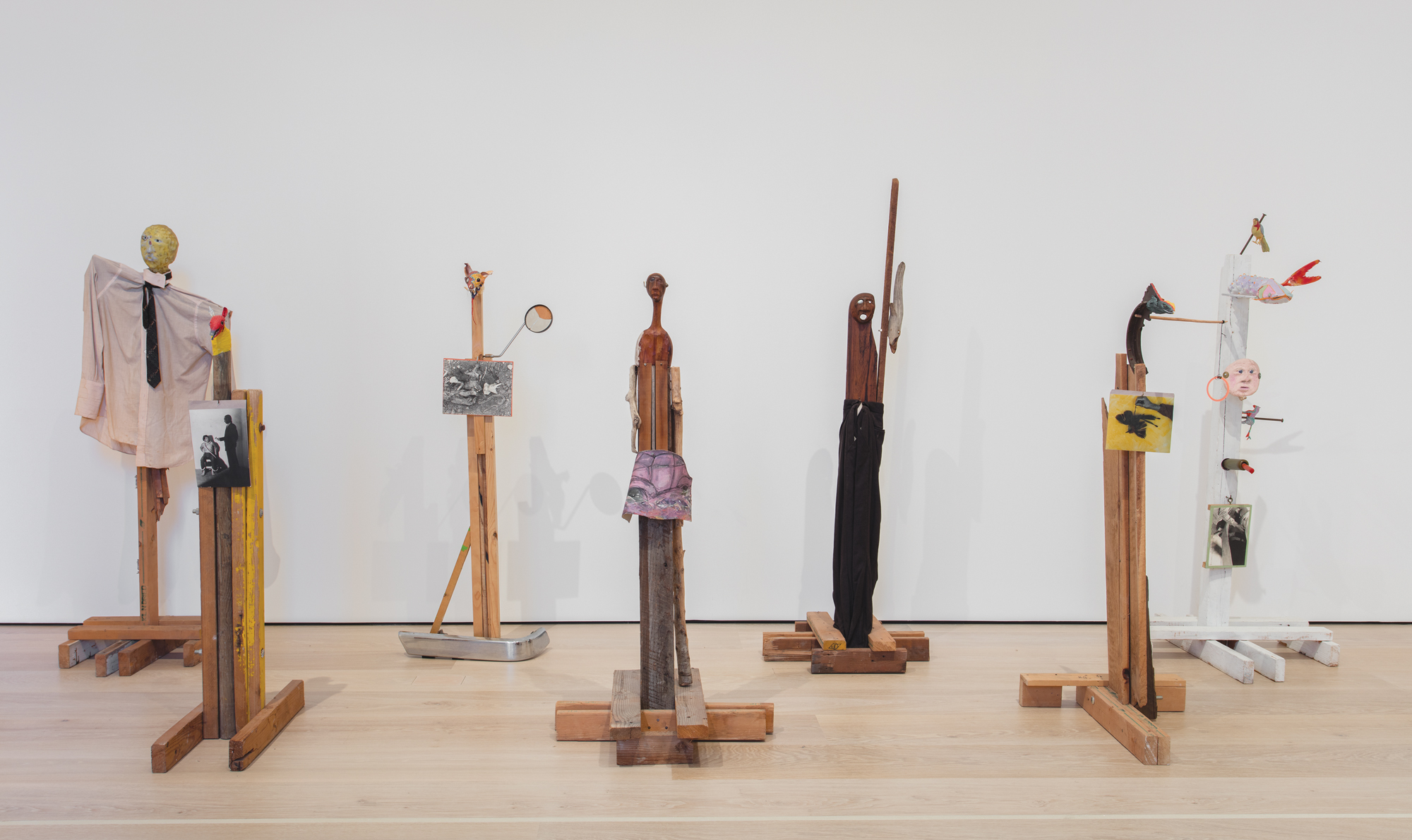
View of "Jimmie Durham: At the Center of the World." Hammer Museum, Los Angeles. 2017. Photo: Brian Forrest.
“It is part of morality not to be at home in one’s home.” Adorno’s dictum, a pit in Minima Moralia’s feast of bitter fruits, is largely understood to mean that serious ethical work demands a taking of distance. “Wrong life cannot be lived rightly.” A similar motive might be lent to the expatriation of Jimmie Durham, now living in Naples, Italy, via Cuernacava, Mexico, and some half-dozen other European cities, who last set foot inside these borders in 1995. Durham is, arguably, among the best American sculptors working today — arguably best insofar as his retrospective at the Hammer Museum in Los Angeles makes a sterling case for it, and arguably American because Durham has questioned the substance of that adjective for nearly half a century. “Where I was born,” he stated in 1994, “is a political situation called the US, not in a so-called ‘state’ of the US.” That so-called state, if you would know it, is Arkansas, and the situation is colonial: the longstanding, unrepentant larceny of the land belonging to Durham’s Cherokee ancestors, along with hundreds of other indigenous American nations. Durham is as American as Adorno is German. For them, there can be neither detachment from, nor reconciliation with, states whose hegemonies were shored up by the annihilation of their kin.
Anne Ellegood, who curated the Hammer exhibition, describes Durham as a “post-American artist” on these terms: not one who has shuffled off his origins, but rather one who has unyoked his identity from the ideologies of American nationhood, and then returned to clout, hammer, disjoint, deface, abrade, inscribe, and unspool them. Durham spent the greater part of the 1970s organizing for Indian rights before he resumed making art. His activism and his identity tend to circumscribe his reputation as a “mocking miscreant,” in the words of art historian Jessica L. Horton, whose oppositional stance saddles his work with the affective and formal negativity of the trickster or savage. The wager of Durham’s magisterial retrospective (which tours later this year to the Walker Art Center in Minneapolis and then to the Whitney Museum in New York) is that recognition of his oeuvre requires something positive — namely, a place, preferably a large one. “I feel fairly sure that I could address the entire world if only I had a place to stand,” Durham said in 1988, a year after departing the US for good. Ellegood’s strategy for securing this place is straightforward: an elegantly and expertly staged retrospective that remains, notwithstanding a sizeable number of drawings and videos on display, an exhibition of sculpture. Sculptures, too, make a bid for a place to stand.
That sculpture lies at stake here — not just for Durham, but for his unmasking of the American mythos — is signaled right from the exhibition’s start, with Durham’s Self-Portrait (1986): a canvas silhouette, painted terracotta pink and annotated with both disarming first-person exclamations and clinical third-person memoranda. It masquerades as the absent artist’s surrogate in order to engage the doublespeak of conventional figurative sculpture: an “expressive” surface, achieved through the sublimation of clay, bronze, or marble. “Hello! I’m Jimmie Durham.... I have 12 hobbies!” the sculpture reads, alongside a report of his various addictions. “I am basically light-hearted!” it announces below a small, square hole in the canvas, peeled open to expose a heart of canary-yellow chicken feathers. Roll your eyes at the pun, but the hole in Durham’s heart nevertheless directs attention to the sculpture’s underlying armature of driftwood, broom handles, and animal bones. Self-Portrait’s tentative attempts to articulate Durham’s identity are (literally) undergirded by matter that will not surrender its own history just to give voice to the surface.
Assemblage makes a handy shorthand for Durham’s practice, mapping it over the common ground shared by avant-garde sculpture, religious fetishes, and the handiwork of backwoods bricoleurs. In some of his more arresting works, that assemblage technique is enough to account for their combination of formal force and uncanny smolder — the hieratic pair of Cortez (1991–92) and Malinche (1988–92), for instance, whose piecemeal bodies of pine branches and cactus, car parts and leather, evoke both the violence and passivity of the colonial enterprise. The crescendo of the Hammer’s show was the 23-foot-long Something...Perhaps a Fugue or an Elegy (2005), which comprises a platform decked with skulls and bones as well as video cameras and a radio, amp, and TV, all of it connected by wires and pipes like a Rube Goldberg machine. It suggests a colossal surrealist object, a technological reliquary, or perhaps a hoarder’s porch. Surely, the uncertainty of its “true” nature is Durham’s provocation.
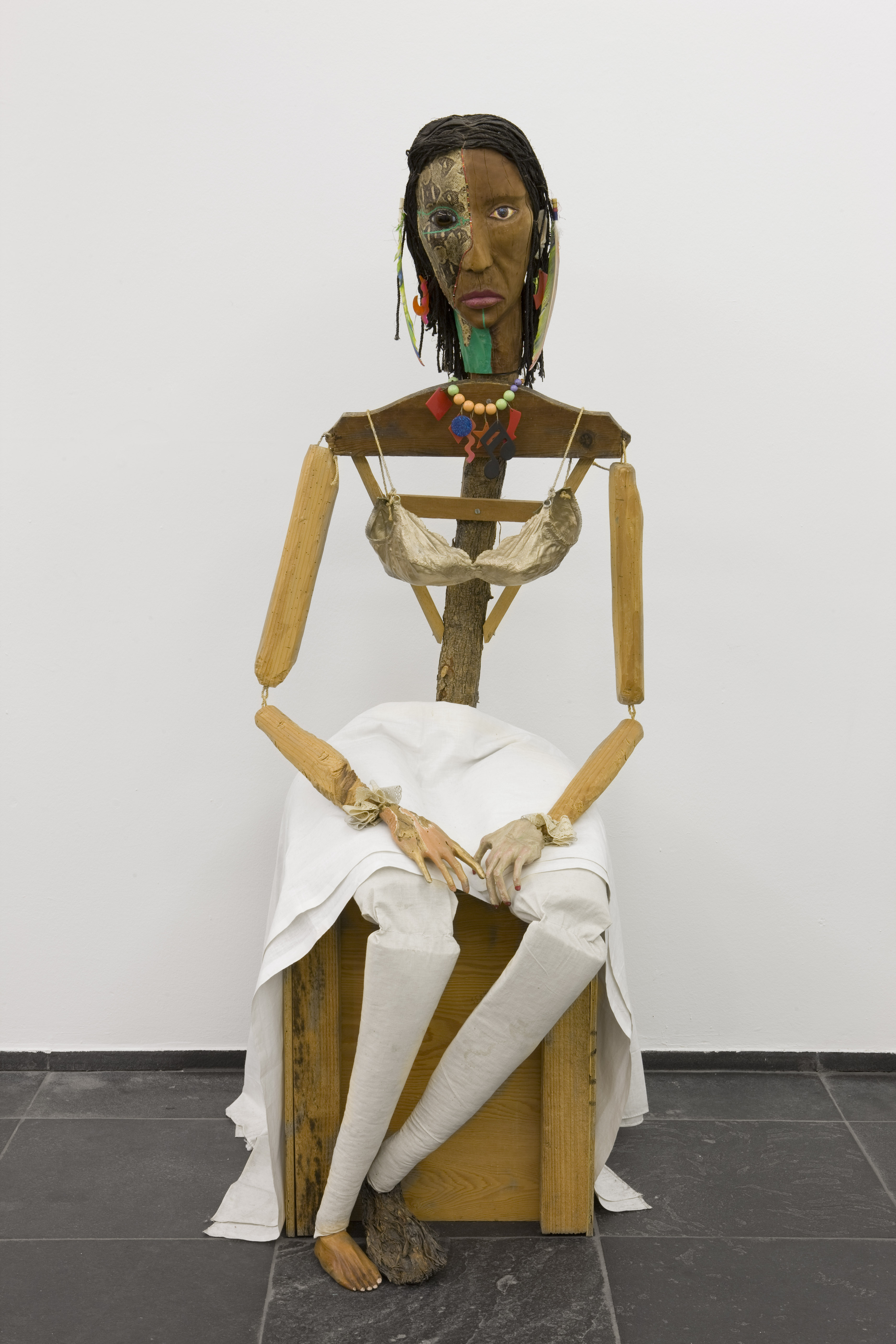
Yet it’s language that sets the tone of the retrospective. Durham has called the written components of his work footnotes or parentheses, but in practice, their function is far more variable and active. Words often accompany Durham’s sculptures, often via labels that parody the displays of natural history museums, enjoining viewers to examine a case of petrified charcuterie, a taxonomy of arrow-types (“TINY... WAVY... SHORT+ FAT”), or Pocahontas’s feathered panties. But language is just as often given over to the sculptures themselves. A stiffened wad of dirty canvas extends a tiny banner from one formless limb, and on it you can read: “Mr. Durham made me without stopping to think of his art career nor, I am sorry to say, the sensitivities of the general art public.” Another canvas, doubling as a didactic panel, is forced to suspend its monologue about a prehistoric stone tool to register, in theatrical Stops and Nos, the blows of the offending cudgel that now sits peaceably on a shelf beside it. Such works are cuter than they are clever. They function, however, as cues — reminders that the voice speaking in his captions is labile, sliding from artist to material. It’s precisely the instability of this voice that gives his sculptures their polyphonic charge.
Can a sculpture speak? That question seemed to be at issue on the other side of this grand colony of ours, in a divisive exhibition by the Cercle d’Art des Travailleurs de Plantation Congolaise (the Congolese Plantation Workers Art League), at SculptureCenter in New York. The artists of the CATPC live and work in an impoverished province of the Democratic Republic of Congo; most have never been to Kinshasa, let alone one of the art world’s major capitals. Yet one of them, the sculptor and palm-nut cutter Mathieu Kilapi Kasiama, came to New York for the CATPC’s first American exhibition. Also in attendance: Renzo Martens, a Dutch artist infamous for his 2008 film Enjoy Poverty, which documented his attempts to convince Congolese commercial and wedding photographers to turn their lenses on local scenes of violence and suffering for a share in the first-world media’s money. Martens has since moved to the DRC and founded the Institute for Human Activities (IHA), described as the CATPC’s sister organization, but perhaps more accurately understood as both umbrella organization and impetus. Together, the IHA and CATPC are collaborating on yet another acronym, the LIRCAEI, or Lusanga International Research Centre for Art and Economic Inequality: an art gallery and research center, designed pro bono by Rem Koolhaas’s architecture firm OMA, which opened last month. A press release announces the imminent “repatriation of the white cube.”
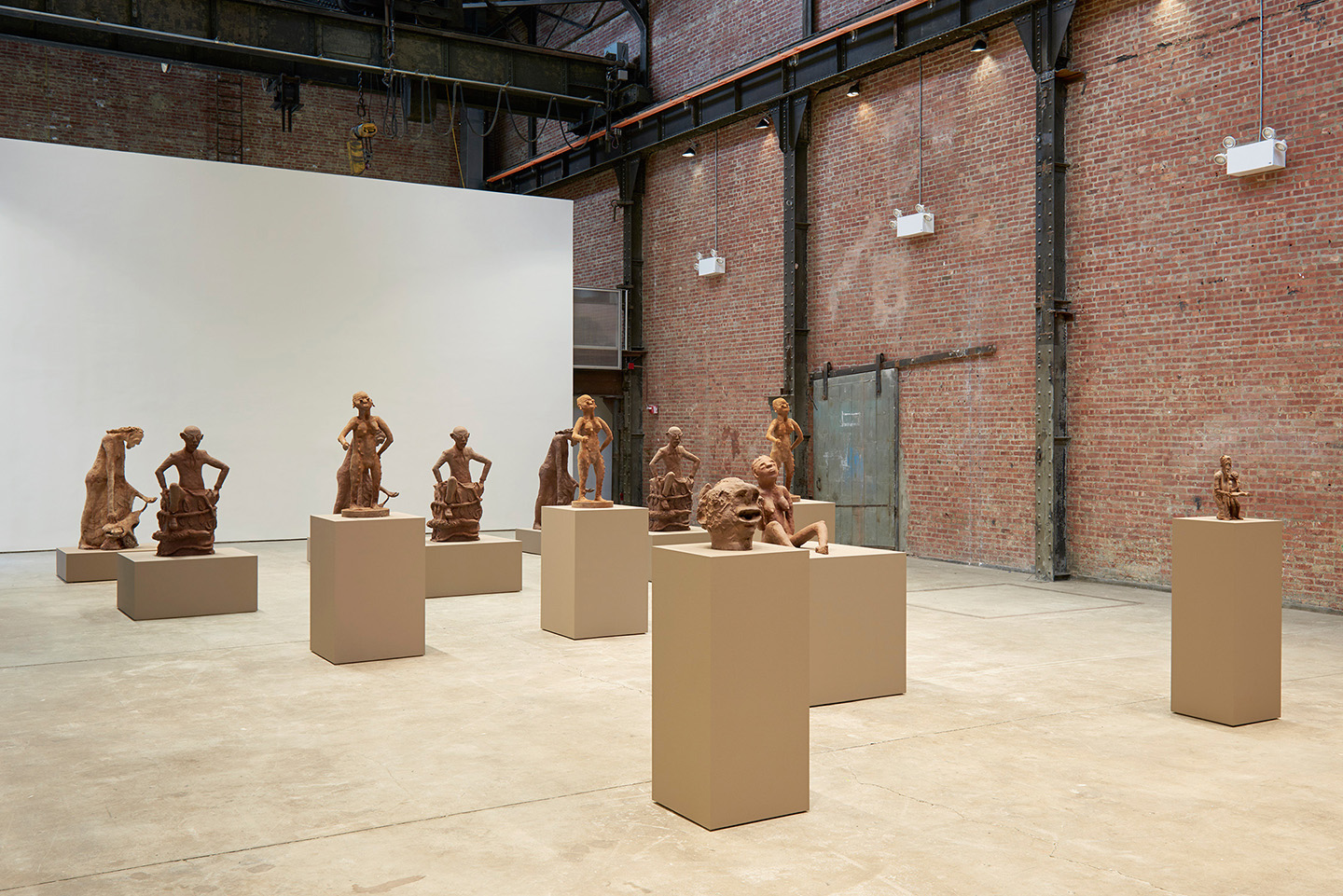
The CATPC was founded in 2014 near the town of Lusanga, and currently comprises 11 plantation workers, as well as the ecologist René Ngongo and the Kinshasha-based artists Michel Ebeka, Eléonore Hellio, and Mega Migendi. Lusanga, at least, is the town’s name since independence; under colonial rule it was called Leverville, after the plantation of the Lever Brothers, who set up there in 1911 with the backing of Belgium’s genocidal King Leopold. The Lever Brothers soon built their operations into the global food corporation Unilever, now the world’s largest consumer goods company, which paid poverty-level salaries to cutters like Kasiama. But in the 2000s Unilever sold off its land in Lusanga, still owing some $24 million in unpaid wages, and abandoned the region to economic freefall.
Enter the CATPC, who aim to invert the longstanding system of third-world exploitation and first-world accumulation of both financial and cultural wealth. The collective describes itself as a “grassroots platform for the development of new economic initiatives based on the production and sale of critical art.” Put simply, its goal is to use art to raise money — although the wit of the CATPC’s phrasing will not be lost on those with an ear for art world rhetoric: it’s a mirror image of the PR blather used to promote such programs as Tate Modern’s Turbine Hall commissions, which were funded for years by none other than... the Unilever corporation. Proceeds raised by the CATPC’s sales — some €50,000, by one account; it may be more by now, as works by the collective also appeared at this spring’s Armory Show — are returned to the collective, who determine how to use the funds. If the plantation workers cannot make ends meet from their labor, then why should they not turn that labor into art, and earn much more?
Nothing’s ever so simple, however — or so the exhibition seeks to remind us. The CATPC’s modest presentation included six sculptures, which were made to run the paces of the products of plantation labor. Carved by the league’s members in the DRC, then 3-D scanned, the sculptures were printed in Amsterdam and cast in Belgian chocolate, before debuting in a first-world gallery alongside drawings and a video. Arranged in rows on evenly spaced pedestals, the installation summoned up a sepia tint of a plaster study room in a 19th-century art academy. In the first ranks were Cedrick Tamasala’s How My Grandfather Survived (2015), two figures arranged side by side before an open book, as expressive as the famous tomb figures of the medieval dukes of Burgundy, and Mubuku Kimpala’s self-possessed Self-Portrait without Clothes (2015), which channels the Möbius fluidity of Matisse’s 1909 bronze La Serpentine, but exchanges the latter’s remoteness for striking candor.
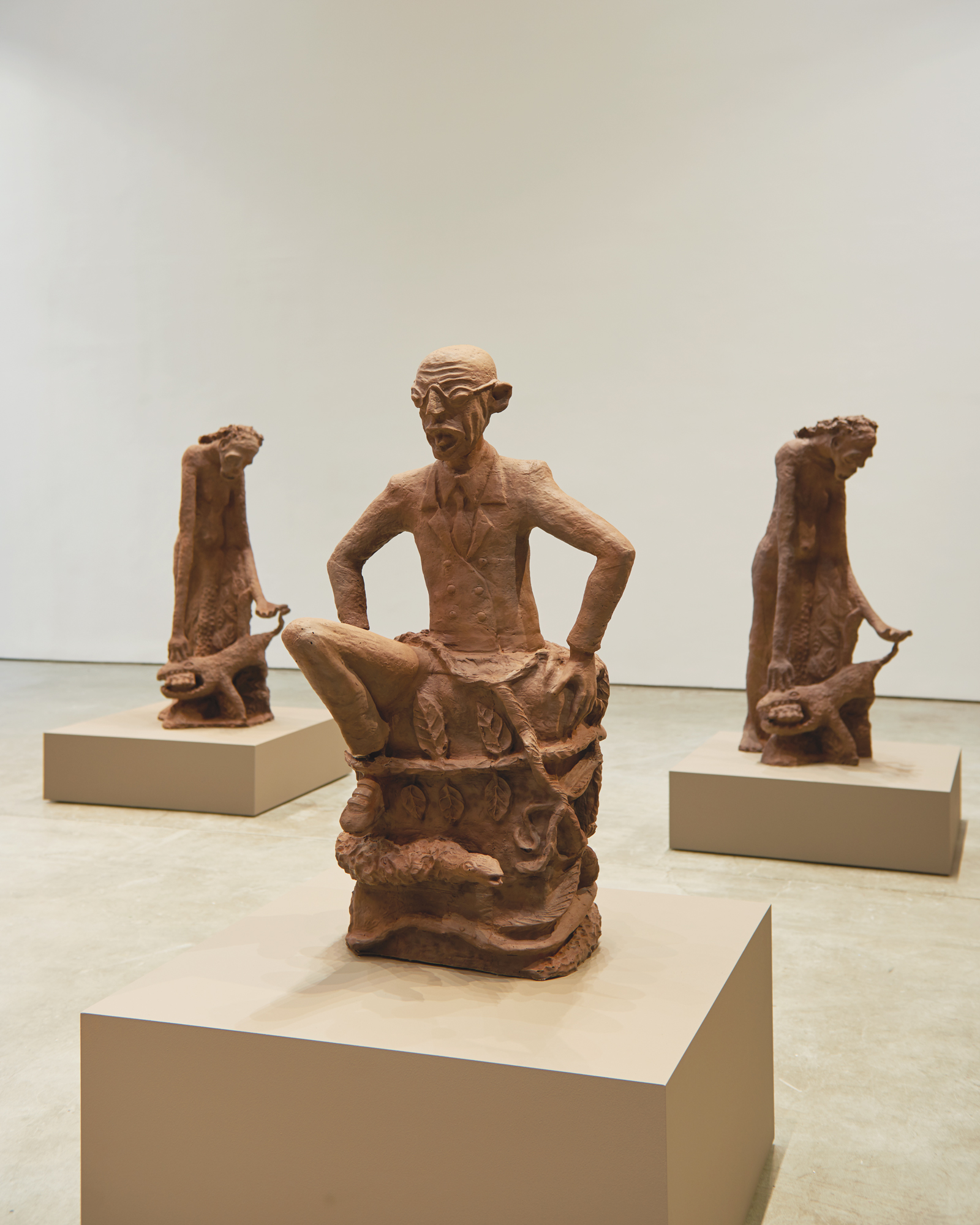
But it was the more monumental work that stole the show. In Thomas Leba’s Poisonous Miracle (2015), an old woman gazes down in horror at her foot, which has been trapped in the maw of a mammoth chameleon. From one angle, the couple form a single unit, anchored architecturally by her down-stretched arm. But the sculpture seems to press forward into space as one circles it: the figure detaches from the beast, and its poignant profile — mouth gaping and palm upturned as though baffled by the chameleon’s ferocity — is complemented by ornamental leaves embossed into the spandrel between the reptile and her leg. The transformations of the chameleon infect the sculpture itself, as it folds out of the monolithic block of brute material. Yet the chameleon is also an allegorical figure for another transformation: the arrival of capitalism to the Congo. The choice of Belgian chocolate as a medium reflects this history, one in which cocoa beans were sent to Europe, but nothing rich — and certainly no chocolate — was sent back. Plantations were not just operations; they were ideologies, justifying the treatment of resources, people, and their sculptural “fetishes” alike as raw material that must subsequently be refined into first-world luxuries. A plantation workers’ art collective is transgressive because it establishes intimacy with material has been historically denied to them: not chocolate, but sculpture.
One of Durham’s more recent works suggests a first-world pendant to these chocolate casts. Upon reflection, I was no longer sure of my position (2009) is a long table decked with one large hunk of obsidian, black volcanic glass used extensively in pre-Columbian Mesoamerica, and a cast of the same shape in “German silver.” Hanging on the wall behind the silver cast is a small obsidian mirror, an accessory of the Aztec deity Tezcatlipoca and an instrument of black magic: a means for crossing over, something integral to both the process of casting sculpture and the life of the expat.
The uncertainty expressed in the title of this Durham work also implies a reflection on his place as a sculptor, between the physical, dangerous task of chiseling obsidian and the remote, literally untouchable process of casting in silver. While Durham’s work holds these sculptural and cultural/colonial tensions in suspension, the CATPC exhibition did not appear to carry off the feat for all its viewers. This set off a telling exchange between Ruba Katrib, the show’s curator, and Ania Szremski, a critic for the website 4Columns, which agitated many social media feeds in the New York art world. Their debate over the potential exploitation of the workers, and of Martens’s role as art-world facilitator or European parasite, ended in stalemate. But Szremski offered supercilious praise that their discussion did “what the CATPC project does best: incite debate.”
Is that really what CATPC does best? I don’t think that’s true, and the move to cast the CATPC as a discursive project betrays an unfortunate reluctance to write about the works themselves. One could attribute it to the nature of their installation. Despite exhibiting only six sculptures, Sculpture Center’s space appeared full because several of these works were there in triplicate. Arranged by size and evenly staggered, they called to mind an impressive, and impressively perverse, display at a candy store around Easter — a vulgar seriality of chocolate things, underscored previously by Paul McCarthy and Dieter Roth. This installation undermines even as it appears to satisfy (triply!) Szremski’s desire to hear the plantations workers speak in their own voices, to “upend the hierarchies” of those who can speak and those who cannot. Expression, after all, is the platform for the CATPC’s economic initiative, not the reverse. It is the nature of the project to demonstrate those hierarchies in the continuing operations of the exploitation/plantation machine, even as it works to divert profits back to the Congo.
So far, these profits have gone toward buying back land from foreign owners in order to build a nebulous “post-plantation.” This, too, suggests the project’s spatial rather than discursive character. Whatever that post-plantation might be, one can suppose that — like Durham’s “post-American” practice — it will entail a return to the land, not as Arcadia, but as a material place sown with exploitative legacies that render the workers exiles-at-home.
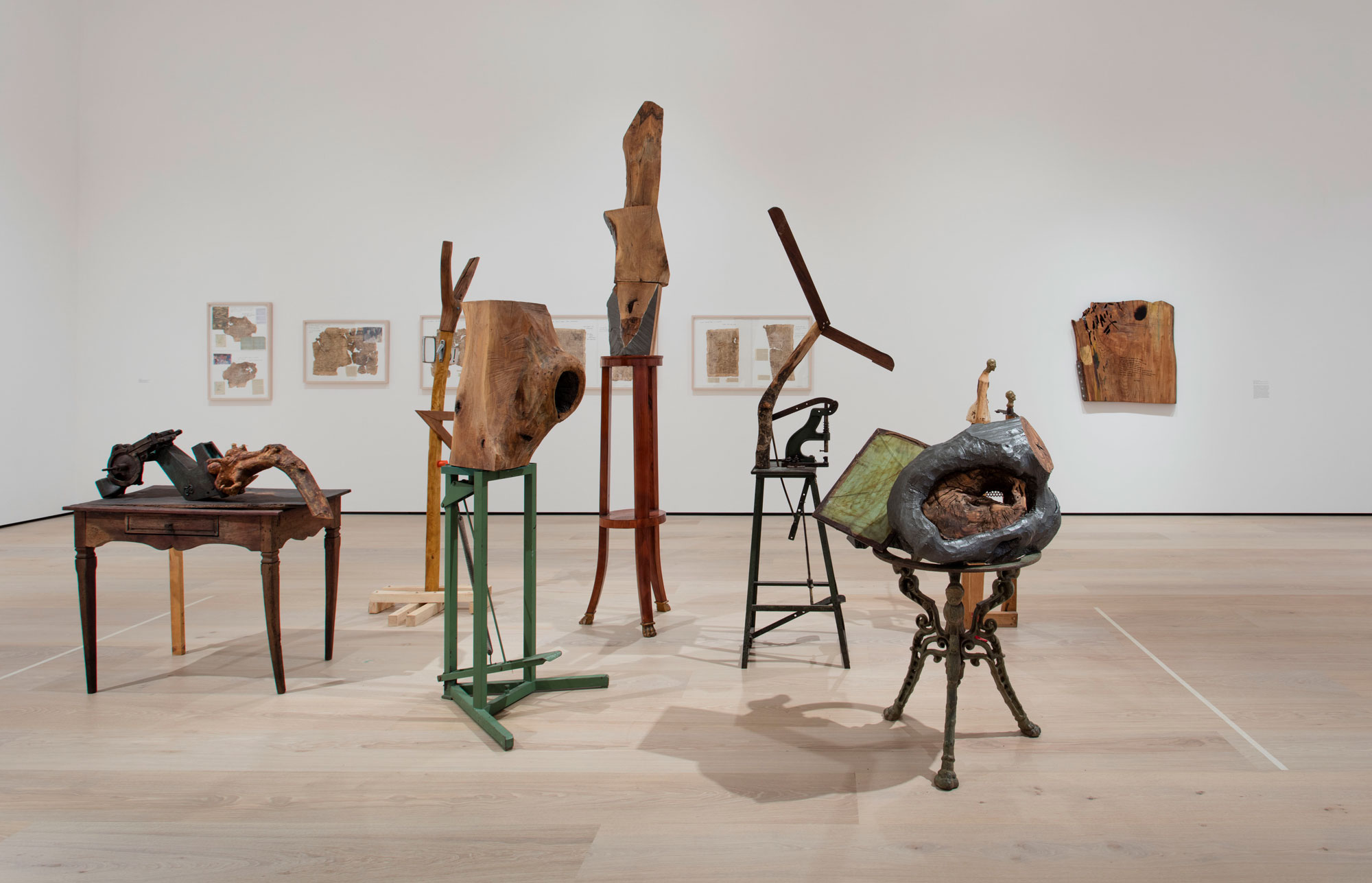
Here and yet not-here, there and yet still-here, exiles get from their maladjustment, to the redeeming eye of Edward Said, not “a privilege but an alternative to the mass institutions that dominate modern life.” There is at present no mass institution as dangerous as nationalism. Ellegood spent ten years convincing Durham to agree to an American retrospective, and this one arrived not a minute too soon. It is the wretched lesson of Trump’s election that “blood and soil” nationalism is alive and well, even though the soil is stolen, and the blood is (always) bogus. Against this colonial construction that exploits and exacts violence in proportion to its spuriousness, Durham’s sculptures insist that the grounds of representation are concrete, and what is concrete can be voiced.